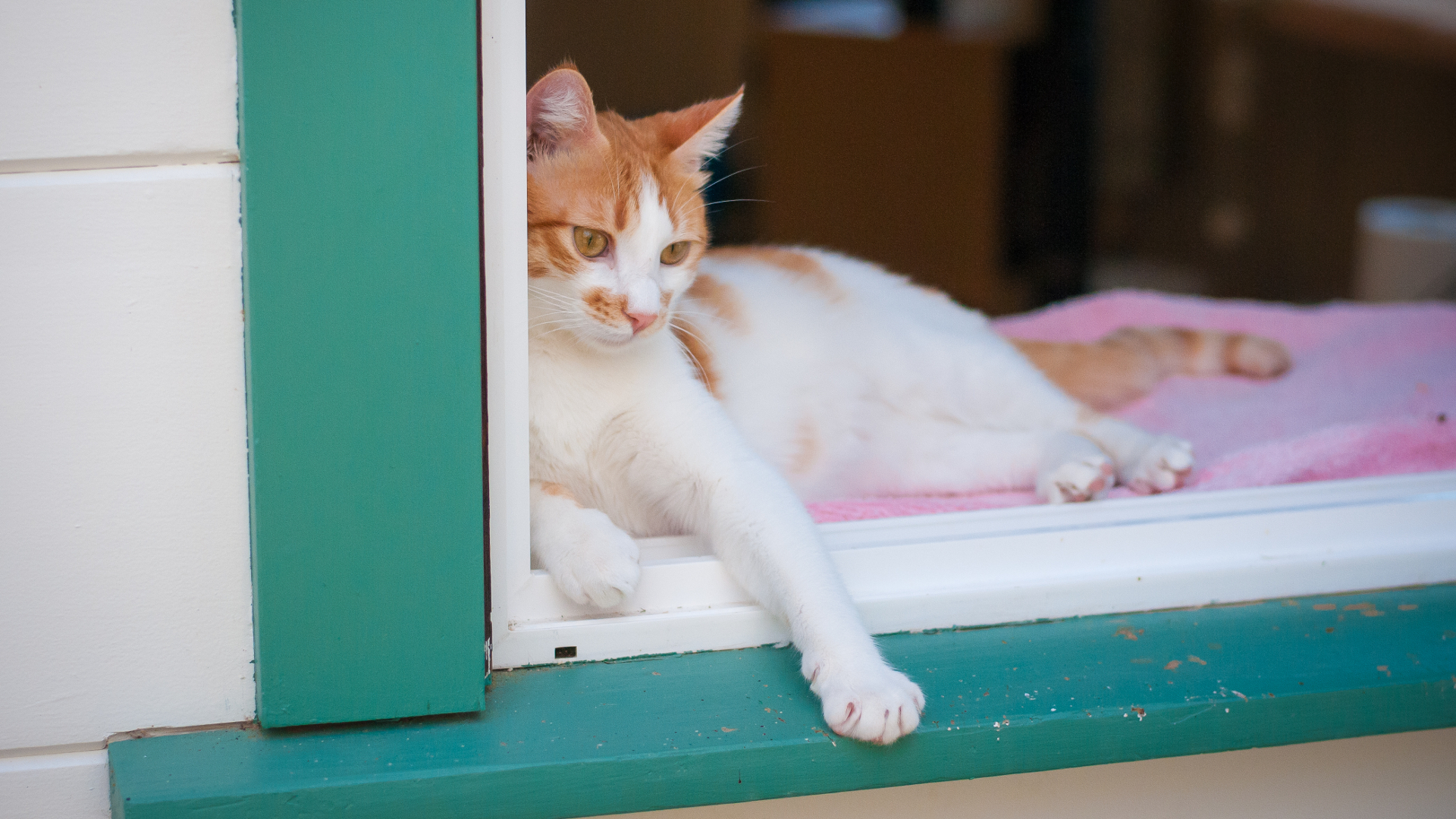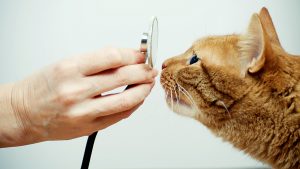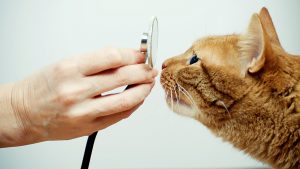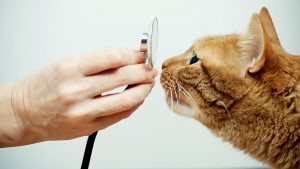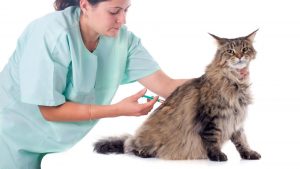Feline Aggression
Provided by the Cornell Feline Health Center, Cornell University
Aggression in cats can be a complicated and upsetting problem for owners to solve. An aggressive cat can be very dangerous, especially toward children who may not be able to recognize the physical cues that are the warning signs of aggression. Additionally, cat bites and scratches are painful and can transmit disease.
The different types of aggression are not mutually exclusive. Your cat may show more than one type of aggression, and the problems may be more or less serious than those described below. However, some general principles apply to all types and levels of aggression:
My cat is aggressive toward me and my other cat. What should I do?
Because aggression may be caused by a medical problem, first take your cat to your veterinarian, who will perform a physical examination and appropriate diagnostic tests. Painful conditions, like arthritis and dental disease, as well as central nervous system conditions and hyperthyroidism, have all been implicated in aggression. Alleviation of underlying medical conditions often resolves the aggressive behavior. Once medical causes have been ruled out, it is important to determine what kind of aggression your cat is displaying in order to formulate a management strategy, and ultimately, a solution.
My kitten sometimes bites and scratches me when we play. I know kittens love to play, but her attacks are painful.
Biting and scratching during play are typical of play aggression, a behavior most commonly observed in young cats and kittens. Kittens raised with littermates learn how to bite and scratch with reduced intensity, because play that is too rough causes pain to a playmate, resulting in either retaliation or the cessation of play. Consequently, play aggression is usually seen in kittens that were not raised with littermates or playmates, are under-stimulated, or lack appropriate play outlets.
Play aggression can usually be recognized in a kitten’s body posture. The tail lashes back and forth, the ears flatten against the head, and the pupils (the black part of the eyes) dilate. This sort of posture usually develops from normal play and is followed by biting and scratching. Kittens that stalk moving objects, like your hands and feet, are also displaying play aggression. Play aggressive cats often stalk or hide, then jump out and attack as you pass.
Try keeping a record of when this occurs to see if there is a pattern. You may learn, for example, that your kitten tends to hide under your bed and jump out as you’re getting ready to go to sleep. By anticipating this, and encouraging play prior to the attack, you may be able to curb this behavior. A bell on a breakaway collar around your cat’s neck clues you in to his whereabouts. You may need to deny him access to his favorite stalking places in order to stop this behavior.
Another management technique is to use noise deterrents, such as a human-generated hiss, or a blast from a compressed air canister. These must be used within the first few seconds of the onset of aggression to startle, rather than scare the cat, into ceasing his behavior. Do not physically punish your cat, even with a slight tap on the nose. The pain of being struck can lead to more aggressive behavior, and your kitten will learn to fear and avoid you. Additionally, any physical contact may be interpreted as play, which rewards your kitten’s rambunctious behavior. Simply walking away and ignoring your kitten is much more effective; it teaches him that the consequence of rough play is no play.
All of your play objects should be at a distance from your hands, so your cat has no opportunity to bite or scratch you. For example:
My ordinarily nice cat gets very agitated whenever anyone new comes into the house; she has even attacked some visitors.
These are signs of fear aggression a defensive behavior toward unfamiliar stimuli, like people, animals, and noises. Unpleasant experiences, like a trip to the veterinarian’s office, may also trigger fear aggression. A cat displaying this sort of aggression hisses, bares her teeth, and crouches low with her tail and legs tucked under her body. Her ears are flat against her head, her pupils are dilated, and her fur stands on end.
The management of this problem involves identification and, if possible, avoidance of fear-eliciting stimuli. You can attempt a gradual desensitization program, in which your cat is exposed to such stimuli a safe distance away for short periods of time, then rewarded with food treats for non-aggressive behavior. For example, if your cat has a fear of men, a man might stand at a distance that does not trigger aggressive behavior in your cat. Your cat gets a treat for her calm demeanor. With each session, the man moves closer, and gradually, the cat learns to associate the man’s presence with a tasty treat.
There are two important things not to do with a fear aggressive cat:
My cat kills outside mice and birds. I worry that he will attack our pet gerbil.
A normal, instinctive desire to hunt prey, predatory aggression includes the stalking, chasing, and attacking of rodents and birds. This behavior is inappropriate when directed toward humans, and can be disturbing when directed toward wildlife or small indoor pets.
A cat on the prowl shows hunting body postures. He slinks with a lowered head and a twitching tail, and lunges when the prey is within reach. Because this behavior is instinctive, it is especially hard to control. There are, however, some effective management strategies.
If your cat shows predatory aggression toward indoor pets like gerbils, hamsters, or pet birds, it is wise to deny him access to those animals. If you do not want your cat to hunt wildlife, consider keeping him indoors. Some wildlife can also be deterred from your property by removing bird feeders and using tightly sealed garbage containers.
Putting a bell on a breakaway collar around your cat’s neck so you know his whereabouts can help foil his sneak attacks on people. Take precautions with infants and toddlers, who are especially vulnerable to predatory aggression.
My arthritic cat growls and hisses when I pick her up to give her medicine. I don’t want to hurt her, or be hurt, but I have to give her pills.
A cat that dislikes being touched in a painful area may display pain-induced aggression in an attempt to stop you from handling her. This behavior can also be associated with past trauma. For example, a cat whose tail was once caught in a door may continue to resent any touching of his tail long after the pain is gone.
Resolving or alleviating the pain is the best way to manage this problem. However, like the arthritic cat described above, you may need to handle a cat in pain in order to treat her. If so, handle her as gently as possible, wear gloves if necessary, and give her food treats so that she associates your touch with a tasty reward. If she acts aggressive while you are handling her, do not reward her with kind words and petting; this demonstrates that aggressive behavior is acceptable. Finally, ask your veterinarian about medications that can help your cat cope with her pain.
Sometimes when I approach my cat while he’s on the windowsill looking outside, he turns around and swats at me, unprovoked. Why?
Redirected aggression typically occurs when a cat is aroused by one stimulus, but another pet or person intervenes. In the example above, a bird outside the window may have stimulated the cat, but the unsuspecting owner became the recipient of the lashing instead. A cat exhibiting redirected aggression may growl and pace; his hair stands on end, his tail swishes, and his pupils dilate.
Avoid the cat until he is calm. Interaction can lead to injury, and any attention, including punishment, may encourage his behavior. You may have to gently herd your cat to a quiet, dark room for a “time-out;” if necessary, use a thick, folded blanket or a board to protect yourself from injury. Periodically, enter the room, turn on the light, and put down a bowl of food. If your cat is still aggressive, turn the light off and leave. If he is calm, pet and praise him.
If your cat has exhibited redirected aggression toward another cat in the house, re-introduce the two cats slowly, once the aggressor has calmed. Place the cats on opposite ends of the room and feed them; if necessary, you can place each cat in a carrier to ensure their safety. This will allow both cats to associate food with the other’s presence. Such behavior modification techniques are important for maintaining household harmony; if severe redirected aggression occurs regularly, your two cats will learn to fight whenever they are together.
You may be able to prevent your cat’s redirected aggression if you can identify the stimulus that sets him off. However, if the stimulus is an outdoor noise, smell, or sight, you may have to block your cat’s exposure to the outside world. You can install electronic mats that deliver a harmless, mild shock, or put sticky tape on your windowsills. Window blinds are also effective deterrents. You can discourage outdoor animals from coming near your house by installing motion-activated sprinklers, removing bird feeders, and using well-sealed garbage containers.
Finally, you can interrupt redirected aggression between cats by immediately startling them with a water gun or shaking a jar of pennies. This sort of remote punishment keeps you from getting hurt, and if consistent, may discourage further attacks.
My cat begs for attention, but when I pet him for too long, he lashes out and runs away.
A cat exhibiting petting-induced aggression will usually seek out attention, but at some point while being petted, he acts as though he’s had too much, and he attacks.
Although a tensed body, flattened ears, and lashing tail are typical of the warning signs a cat gives before an attack, cat owners must learn to recognize signs that are particular to his or her cat. Young children are especially at risk because they may be unable to read a cat’s body language.
To manage this problem, examine the ways in which you handle your cat. Try holding or touching your cat only when he seeks you out; avoid uninvited handling, physical punishment, or picking up your cat when he’s eating. When petting your cat, do not use physical restraint; this can increase his anxiety.
You can systematically discourage your cat’s petting-induced aggression with the following tactics: Entice your cat onto your lap with a tasty treat, and lightly stroke him. Well before you detect his aggressive warning signs, place him on the floor with a treat to reward his peaceful behavior. Gradually increase the length of time you spend petting him, and he will learn that calm interactions are followed by treats.
The hardest part of dealing with petting-induced aggression is accepting that your cat has limits to what he will tolerate. Yours may never be a cuddly cat, but he can learn to interact without violence.
Our cat growls and hisses when we try to move her off our bed, although she constantly seeks our attention.
This cat is attempting to control the situation through status-induced aggression. Other examples include cats that block doorways, or solicit attention from their owner or another cat by biting or swatting them as they pass, often with unsheathed claws. The signs of this kind of aggression include tail swishing, flattened ears, dilated pupils, growling, and hissing.
To manage this cat, the owners must ignore the cat’s demands for play, food and attention; such rewards must only be given when the cat is relaxed. A relaxed cat holds her tail up, has normal sized pupils, and does not swat. Owners should never physically punish their cat; even a harmless tap on the nose may be viewed as a challenge and the cat may become even more aggressive. The most effective reaction to status-induced aggression is to ignore the cat completely.
My cat has been very nasty toward the new cat I just brought home. They have violent interactions and I worry that they’ll hurt each other.
Cats tend to defend their territory by exhibiting territorial aggression when a new cat is added to the household, and even when a resident cat returns from a hospital stay bearing unfamiliar smells. Owners often observe the territorial aggressive cat swatting, chasing, and attacking the new or returning cat.
The most effective management of territorial aggression is to prevent it from occurring when first bringing home a new cat. However, the following steps can be taken even if you have already introduced a new cat and your cats are brawling. All of the following steps should be taken slowly; rushed introductions are the most common cause of failure.
We took in a pregnant stray cat that recently gave birth. The mother cat gets very agitated and hisses if we try to approach her or the kittens.
The mother cat has maternal aggression. This behavior usually subsides as the kittens age. In the meantime, it is best to provide a low stress environment, keep visitors to a minimum, and avoid approaching or handling either the mother or her kittens if you are met with maternal aggression.
If you must handle the mother cat during this time, she can be muzzled or gently restrained. If the kittens need to be held, try to entice the mother away with some tasty food.
Our two male cats wake us up with fighting and hissing.
Male cats are often involved in inter-cat aggression, which usually erupts as one cat reaches social maturity at two to four years of age. Although this type of aggression is usually seen in males due to hormone-driven competition for mates, it can occur between cats of any sex when territorial conflicts occur. Such cats exhibit the typical signs of aggression: flattened ears, puffed-up hair, hissing, and howling.
Because there is a hormonal component, the first step toward alleviating this aggression is to neuter or spay all cats involved. If this has already been done, the cats should be separated, each with their own food, water, and litter box, whenever they are unsupervised. When you are monitoring them, they should be rewarded with treats for peaceful interactions. Put distinct sounding bells on breakaway collars on each cat so that you know their whereabouts. Immediately startle them with a loud noise (i.e. a compressed air canister, or shaken jar of pennies) or a squirt from a water gun whenever they behave aggressively.
Suggested Products
Cleaners/Deodorizers
Anti-Icky-Poo (AIP)
Bug-A-Boo Chemicals
11924 NE Sumner
Portland, OR 97220
Nature’s Miracle
Pets ‘N People Inc.
27520 Hawthorne Boulevard, Suite 125
Rolling Hills Estates, CA 90274
(Also available at most major pet stores)
Outright Stain and Odor Removal Products
The Bramton Company
P.O. Box 655450
Dallas, TX 75265-5450
Oxyfresh Pet Deodorizer
Oxyfresh USA, Inc.
P.O. Box 3723
Spokane, WA 99220
Pheromone Spray
Feliway
Abbott Laboratories
1401 North Sheridan Road
North Chicago, IL 60064
Electronic Mats
Scatmat/Scarecrow Motion Activated Sprinklers
Contech Electronics, Inc.
P.O. Box 115
Saanichton, British Columbia
Canada V8M 2C3
PetMat Radio Systems Corporation
5008 National Drive
Knoxville, TN 37914
Motion Detectors
Scarecrow
The Dog’s Outfitter
1 Maplewood Drive
Hazleton, PA 18201
(Motion detector that turns on a sprinkler when activated)







